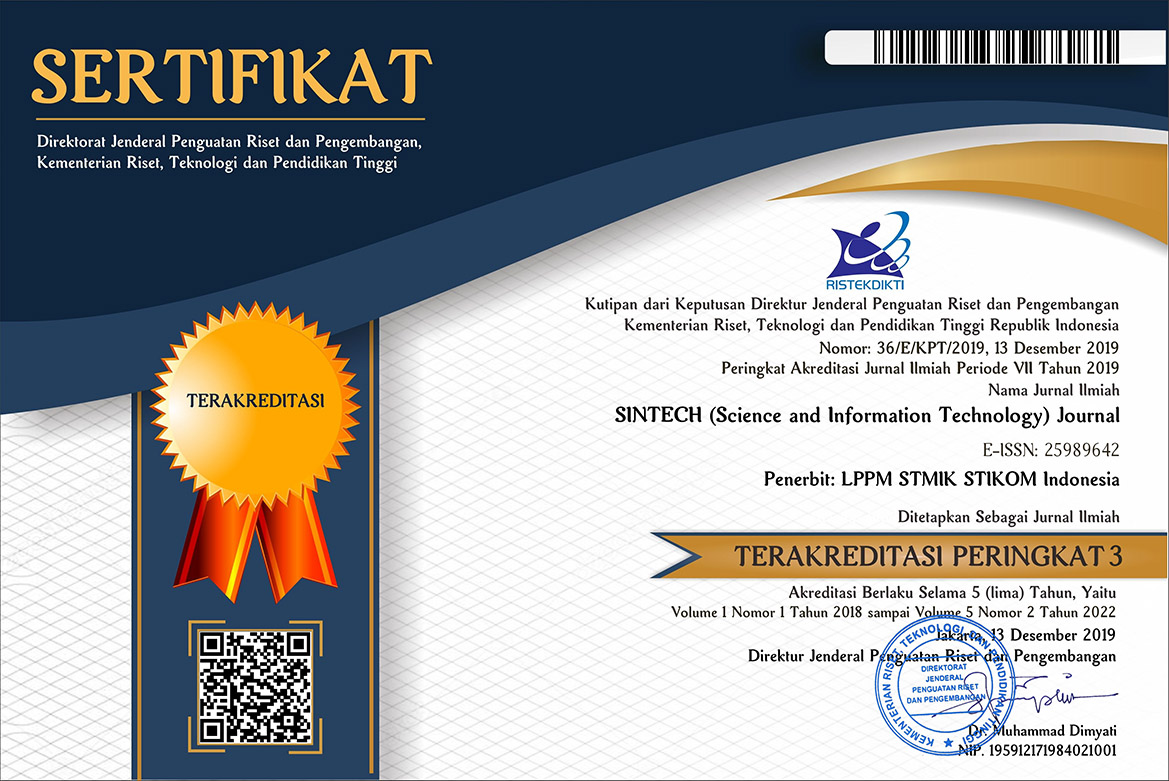Implementasi Metode Convolutional Neural Network Pada Pengenalan Aksara Bali Berbasis Game Edukasi
DOI:
https://doi.org/10.31598/sintechjournal.v6i1.1298Keywords:
Balinese script, CNN, Backpropagation., Educational GameAbstract
Balinese script or also known as hanacaraka, is the writing used by Balinese people to write their language. In general, this script is used to write everyday language and literary language. Balinese script in the past was not only used for writing literature or sacred texts but also for writing everyday language. Balinese script plays an important role in literary writing. The sacred text of the Vedas uses Balinese script in the Sanskrit language. In preserving the Balinese script, itself, Balinese script lessons are mandatory for students from elementary school to high school. In addition to studying at school, interesting learning is certainly needed to attract students' interest. One way is by way of game applications or educational games. This Balinese script recognition application receives input in the form of Balinese script writing characters from the user, then it will be processed by preprocessing and continued with the classification training process using the Convolutional Neural Network (CNN) and Backpropagation methods. The result is a web-based application that can recognize Balinese script writing with the CNN classification method with an accuracy rate of 81.3% and gets a positive response from respondents who have tested the application.
Downloads
References
I. W. S. O. M, “SISTEM PEMBELAJARAN AKSARA BALI UNTUK SEKOLAH DASAR DI BALI BERBASIS WEB MENGGUNAKAN BASISDATA MULTIMEDIA,” 2019.
P. P. G. P. P, Suyoto, and T. S, “PENGEMBANGAN APLIKASI MOBILE PENGENALAN AKSARA BALI KEDALAM HURUF LATIN DENGAN AUGMENTED REALITY,” SENTIKA, vol. 2015, no. Sentika, pp. 237–244, 2015.
B. S. Kurniawan, S. R. Sentinuwo, and O. A. Lantang, “Aplikasi Pengenal Citra Nomor Kendaraan Bermotor Mengunakan Metode Template Matching,” J. Tek. Inform., vol. 8, no. 1, 2016, doi: 10.35793/jti.8.1.2016.12199.
S. Bhahri and Rachmat, “Transformasi Citra Biner Menggunakan Metode Thresholding Dan Otsu Thresholding,” e-Jurnal JUSITI (Jurnal Sist. Inf. dan Teknol. Informasi), vol. 7–2, no. 2, pp. 196–203, 2018, doi: 10.36774/jusiti.v7i2.254.
S. Hartanto, A. Sugiharto, and S. N. Endah, “OPTICAL CHARACTER RECOGNITION MENGGUNAKAN ALGORITMA TEMPLATE MATCHING CORRELATION,” J. Informatics Technol., vol. 1, no. 1, pp. 11–22, 2013, doi: 10.3810/pgm.1998.03.410.
I. W. S. E. P, A. Y. Wijaya, and R. Soelaiman, “Klasifikasi Citra Menggunakan Convolutional Neural Network ( Cnn ) pada Caltech 101,” J. Tek. ITS, vol. 5, no. 1, pp. A65–A69, 2016.
C. A. Lorentius, R. Adipranata, and A. Tjondrowiguno, “Pengenalan Aksara Jawa dengan Menggunakan Metode Convolutional Neural Network,” e-Proceeding Eng., vol. 7, no. 1, pp. 2558–2567, 2020.
J. Briliantio, N. Santosa, G. Ardian, and L. Hakim, “Penerapan Convolutional Neural Network untuk Handwriting Recognition pada Aplikasi Belajar Aritmatika Dasar Berbasis Web,” J. Tek. Inform. Unika St. Thomas, vol. 05, no. 02, pp. 137–146, 2020.
R. A. Pangestu, B. Rahmat, and F. Anggraeny, “IMPLEMENTASI ALGORITMA CNN UNTUK KLASIFIKASI CITRA LAHAN DAN PERHITUNGAN LUAS,” J. Inform. dan Sist. Inf., vol. 1, no. 1, pp. 166–174, 2020.
A. Sudarsono, “JARINGAN SYARAF TIRUAN UNTUK MEMPREDIKSI LAJU PERTUMBUHAN PENDUDUK MENGGUNAKAN METODE BACKPROPAGATION (STUDI KASUS DI KOTA BENGKULU),” J. Media Infotama, vol. 12, no. 1, pp. 61–69, 2016.
R. Susanto and A. D. Andriana, “PERBANDINGAN MODEL WATERFALL DAN PROTOTYPING UNTUK PENGEMBANGAN SISTEM INFORMASI,” J. Maj. Ilm. Unikom, vol. 14, no. 1, p. 46, 2016.
A. N. Putri, “PENGENALAN KARAKTER HURUF HIJAIYAH DENGAN KELUARAN BUNYI LAFAL UNTUK ANAK USIA DINI MENGGUNAKAN METODE CONVOLUTIONAL NEURAL NETWORK (CNN),” 2021.
M. S. Mujahidin, Misbahuddin, and B. Kanata, “RANCANG BANGUN SISTEM PENGENALAN WAJAH BERBASIS RESIDUAL NETWORK,” J. Tek. Elektro Univ. Mataram, 2020, doi: 10.15900/j.cnki.zylf1995.2018.02.001.
M. Adiwijaya, K. I. S, and Y. Christyono, “Perancangan Game Edukasi Platform Belajar Matematika Berbasis Android Menggunakan Construct 2,” Transient, vol. 4, no. 1, pp. 128–133, 2015.
H. Supriyono, R. F. Rahmadzani, M. S. Adhantoro, and A. K. Susilo, “Rancang Bangun Media Pembelajaran Dan Game Edukatif Pengenalan Aksara Jawa ‘Pandawa,’” Pros. 4thUniversity Res. Colloq. 2016, pp. 1–12, 2016.
Downloads
Published
How to Cite
Issue
Section
License
Copyright (c) 2023 I Gusti Ngurah Anom Cahyadi Putra I Gusti Ngurah, I Kadek Agus Andika Putra, Ida Bagus Gede Dwidasmara, Made Widiartha, Ngurah Agus Sanjaya ER, I Putu Gede Hendra Suputra

This work is licensed under a Creative Commons Attribution-NonCommercial-ShareAlike 4.0 International License.
Copyright in each article belongs to the author.
- The authors admit that SINTECH Journal as a publisher who published the first time under
 Attribution-NonCommercial-ShareAlike 4.0 International (CC BY-NC-SA 4.0) License.
Attribution-NonCommercial-ShareAlike 4.0 International (CC BY-NC-SA 4.0) License. - Authors can include writing separately, regulate distribution of non-ekskulif of manuscripts that have been published in this journal into another version (eg sent to respository institution author, publication into a book, etc.), by recognizing that the manuscripts have been published for the first time in SINTECH Journal















1.png)




